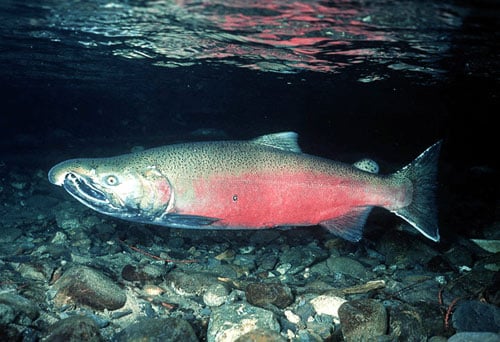Fish Hatchery Information
Figure 3- Coho Salmon heading upstream. Image from www.wildernessclassroom.com
Statistics for the Yearling Ponds
- Mean temp= 10.5o C for yearling pond one and 10.5o C for yearling pond two
- Salinity (ppt)= 12.7 for pond one and 13.6 for pond two
- pH 7.7 for yearling pond one and 8.0 for yearling pond two
- Dissolved Oxygen (mg/L) is 8.8 in yearling pond one, 10.7 for pond two
- Clarity (measured in cm with use of the secchi disk), water clarity is 90+ cm in pond one, and 70+ cm for pond two
- The information on the ponds is credited to Dr. George Allen of the HSU Fisheries Dept. from a study done in 1990.
Species raised in the Arcata Fish Hatchery
The specific species raised in the Hatchery have been picked for numerous reasons, including adaptability to non-natural environments, recreational demand, commercial use, and species population numbers. Through years of testing the correct artificial environments have been found, along with the proper feeding and upkeep methods to ensure fish health.
Coho Salmon
- As seen in Figure 3
- 11-26 inches long
- 2-8 pounds
- The fish take 150 days to leave the rearing pens, they are then moved to the yearling ponds.
Chinook Salmon
- 20-35 inches long
- 3-15 pounds dependant on location
- Can be released 4-6 months after hatched, which is surprisingly quick and therefore are cheaper to produce and stock ponds with.
Rainbow Trout
- 20-30 inches
- 3-8 pounds
- Fed 1.5% of body weight in food per day in the yearling ponds.
- Unlike the salmon, they can lay eggs and not die afterwards. This allows for as many as three spawnings and the fish can reach up to 16 pounds by the time they are five years old.
- Because of the high appeal for recreational fishing of Rainbow Trout, they are often stocked in ponds for anglers to enjoy.
Where do they go?
- Up to 9,000 smolts of salmon are released into the Humboldt Bay each year.
- 5,000-20,000 trout are released into local streams and lakes each year.
- Species information referenced from Aquaculture Network Information Center- http://aquanic.org
- Salmon picture referenced from www.wildernessclassroom.com
